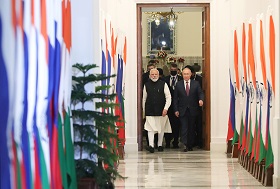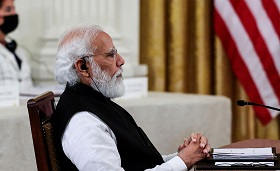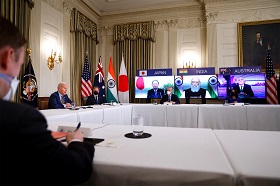After almost two years in the making, the meeting between Vladimir Putin and Narendra Modi was held on December 6, 2021 in New Delhi. The Russian President’s visit was anticipated as never before since the absence of personal meetings at the leadership level turned out to be critical for the bilateral ties moving forward. Only when leaders meet, the relationship may receive an impetus with the existing misunderstandings being downplayed. Chances are high that both leaders will remain in office beyond 2024, so it is increasingly likely that for this decade the relationship will hinge on their decision-making and personal diplomacy. Hence, the summit should be examined not only as another annual event, but rather from the strategic perspective.
This year’s meeting was unusual as it was complemented by a new mechanism—the 2+2 dialogue of foreign and defence ministers. The new track of interaction at the ministerial level has paid off. Setting up the 2+2 dialogue allowed for an exchange of views and concerns on topical regional issues such as Afghanistan, Iran, Syria and even the Indo-Pacific and seemingly facilitated the exploration of convergences in Central Asia, Africa and the Indian Ocean region.
Undoubtedly, China and the United States were, albeit invisible and unmentioned, an essential part of the discussion as Moscow and New Delhi view regional and world affairs through the prism of their equations with these two great powers. Both Russian and Indian sides managed to flag their apprehensions of China’s and the U.S.’s activities in the region. Indian Defence Minister Rajnath Singh highlighted “militarization and expansion of armament in [India’s] neighbourhood” and “completely unprovoked aggression” on its northern border as a major challenge while Russian Foreign Minister Sergey Lavrov shared with his Indian counterparts an apprehension of the U.S. “Indo-Pacific strategies” and the emergence of AUKUS alliance.
The large-scale summit indicated that it is too early to write off the Russia–India strategic partnership, which despite all ebbs and flows retains its viability amidst geopolitical flux. However, to achieve any long-lasting effect for the relationship the two countries should seek to smooth over disagreements in their geopolitical visions and hunt for the new drivers in their relations.
It may be argued that the two nations should take a clear-eyed review of the current state of their ties with an emphasis on intensifying dialogue in the new sectors. The strategic planning for the decade should include not only defence cooperation, but other areas of potential growth, which might emerge as pillars of partnership in the future.
After almost two years in the making, the meeting between Vladimir Putin and Narendra Modi was held on December 6, 2021 in New Delhi. The Russian President’s visit was anticipated as never before since the absence of personal meetings at the leadership level turned out to be critical for the bilateral ties moving forward. Only when leaders meet, the relationship may receive an impetus with the existing misunderstandings being downplayed. Chances are high that both leaders will remain in office beyond 2024, so it is increasingly likely that for this decade the relationship will hinge on their decision-making and personal diplomacy. Hence, the summit should be examined not only as another annual event, but rather from the strategic perspective.
Realignment of regional interests
This year’s meeting was unusual as it was complemented by a new mechanism—the 2+2 dialogue of foreign and defence ministers. The new track of interaction at the ministerial level has paid off. Setting up the 2+2 dialogue allowed for an exchange of views and concerns on topical regional issues such as Afghanistan, Iran, Syria and even the Indo-Pacific and seemingly facilitated the exploration of convergences in Central Asia, Africa and the Indian Ocean region.
Undoubtedly, China and the United States were, albeit invisible and unmentioned, an essential part of the discussion as Moscow and New Delhi view regional and world affairs through the prism of their equations with these two great powers. Both Russian and Indian sides managed to flag their apprehensions of China’s and the U.S.’s activities in the region. Indian Defence Minister Rajnath Singh highlighted “militarization and expansion of armament in [India’s] neighbourhood” and “completely unprovoked aggression” on its northern border as a major challenge while Russian Foreign Minister Sergey Lavrov shared with his Indian counterparts an apprehension of the U.S. “Indo-Pacific strategies” and the emergence of AUKUS alliance.
Judging by the remarks following the talks, regional issues figured prominently in the discussions. In particular, the new iteration of the Afghan crisis has prompted the two sides to keep together. After a series of consultations held in the last three months among national security advisers and diplomatic representatives, Moscow and New Delhi managed to come up with a similar view of developments in Afghanistan. The joint statement issued after the summit indicates that India and Russia share major concerns about the security and political situation in Afghanistan and its wider implications for the region. Both stand for “the inclusive and representative government” and against Afghanistan turning into “a safe haven” for global terrorism. Other examples of similar views are approaches toward the resolution of the Syrian crisis and “the earliest reinvigoration of JCPOA.”
Defence: The pillar and the problem
Apart from certain progress in cooperation over global and regional issues, new agreements in other areas of bilateral ties have been reached. Interestingly, the achievements of defence partnership—the fundamental pillar of the whole relationship—were presented in a low-key manner. Beyond the most-talked-about delivery of S-400 surface-to-air missile system to India, the officials also announced a new program for military-technical cooperation for 2021–2031 and the contract for AK-203 assault rifles production through a joint venture company.
Surprisingly, the long pending Reciprocal Exchange of Logistics Agreement (RELOS), discussed from 2018, “has been put off for some time”, although its necessity for the Armed Forces was pointed out in the joint statement.
More interaction in military-technical cooperation appears to be hidden in the shadows. There are hints that the discussions underway include the licensed production in India of Russian Igla-S man-portable air-defence systems and additional 50 SU-30MKI fighters. Some of the previously signed deals have seen implementation recently with the frigate of 11356 class launch at the Yantar shipyard in Kaliningrad in late October 2021. It is also the lease of one or even two SSN submarines from Russia that is now under negotiation as the primary option for the Indian Navy to keep up its underwater capabilities. Even though the dynamics of bilateral military-technical cooperation seem to have slowed down, the portfolio of deals on the table points to the enduring strategic nature of the relationship.
The issue of U.S. sanctions under Countering America’s Adversaries through Sanctions Act (CAATSA) should be still factored in, even though it has been dismissed by the Russian officials on numerous occasions and disregarded by New Delhi in its decision to go ahead with purchases from black-listed Russian entities. New Delhi will have to keep its head on a swivel while dealing with the Russian defence sector as Washington does not appear predisposed to grant it a permanent waiver. The U.S. authorities may possibly turn a blind eye to the S-400 deal, but would they bear to live with other India’s high-end defence acquisitions from Russia? Explaining to Washington that Russian-origin equipment is utilised against India’s main adversary — China—would scarcely be accepted as an excuse in the long run. Moreover, if the U.S. let India get away with imports from Russia, the whole CAATSA regime against Russia would be deemed futile.
It would be interesting to see in the future how India manages to maintain its military cooperation with Russia against the backdrop of sanctions’ threat. Obviously, CAATSA has become a wrinkle not only for Russia and India, but for the United States itself who needs to come up with a face-saving settlement allowing not to antagonize India, but at the same time to act within the law.
How to address the Indo-Pacific
The major current geopolitical divergence is varying visions of the Indo-Pacific region having emerged as a new forefront of political and economic activity on the one side and regional competition on the other. After an unpleasant hiccup last year, Moscow and New Delhi seem to have brought under control their differing views on the issue, which does not mean, though, that they are on the same page.
At the press-conference, Sergey Lavrov spoke of “identical positions with Indian colleagues” and promised to “do everything […] to prevent the plans of Indo-Pacific strategies, AUKUS and other closed (bloc) formats from trying to prevail over ASEAN and ASEAN-centric structures”. India wholeheartedly supports ASEAN-centrality as well. So do the United States and other nations that have come up with their own Indo-Pacific visions. Yet, New Delhi has resorted to a nuanced stance vis-à-vis AUKUS—it has neither endorsed, nor criticized this agreement while continuing to analyse what benefits it could extract from the emerging situation.
Different naming of the region—Asia-Pacific vs. Indo-Pacific—is just the tip of the iceberg. At the core of divergent perspectives lie different threat perceptions that ultimately impede enhanced regional engagement. The change in respective assessments of the major elephant in the room is not in the offing. However, it should not prevent Russia and India from seeking avenues for mutually beneficial cooperation in transport, infrastructure and other economic projects.
Even though Russia’s opposition to the U.S. strategy in the Indo-Pacific is likely to stay unchanged for a while, it is possible for Moscow to narrow down its differences with other regional perspectives. As Russia’s dialogue with ASEAN countries and Vietnam, in particular, shows, Moscow is ready to “explore promising areas of interaction” in the framework of ASEAN Indo-Pacific Outlook. India’s vision, as should be well realised in Moscow, does not contradict Russian convictions and leaves much space for engagement in a wide range of spheres. By making an exception from its stance and embracing India’s Indo-Pacific Vision, Russia could join several flagship programs of the Modi government like the Indo-Pacific Oceans’ Initiative envisioning joint initiatives in areas ranging from maritime security to maritime ecology to disaster risk reduction and management. It is up to Moscow whether it would be on the sidelines of the regional trends or would try to tap into potential for cooperation with friendly nations, including India.
Russia’s new status of a dialogue partner in the Indian Ocean Rim Association (IORA) and its increasing presence in the region provide for more diplomatic and military interaction with India. Unfortunately, even though there are regular exercises held between navies of the two countries, their interaction remains insufficient. Unlike many other regional partners, Russia does not have a white shipping agreement with India and has not posted its liaison officer at the Information Fusion Centre in Gurugram. As of now, it is clear that more could be done in order to bring the states’ political and maritime visions of the region together.
The remaining bottlenecks
The weakest point of relations with pretty dim outlook is the trade and economic cooperation. Despite the repeatedly expressed commitment to achieve $30bn trade volumes by 2025, this relatively modest target seems unreachable. Although the two states created the framework for a closer interaction in this sphere by establishing a Strategic Economic Dialogue and promoting several business fora, there is no much substance and depth in this domain. There is little hope for the potential signing of the free trade agreement between India and the Eurasian Economic Union and its effect on economic ties at large as after several years of studies and consultations the negotiations have yet to begin.
Some separate success stories of Russian IT and technological companies operating in India have not set the trend so far. Business elites of the two countries remain disconnected and primarily look for the opportunities elsewhere. The only exception is energy cooperation—a unique sphere where Indian and Russian companies continue to increase investments.
President Putin’s reference in his opening remarks to the “green” agenda as a “very important” area for both nations was quite surprising. So far, the two countries have not discussed this issue in detail. Neither environmental problems, nor climate change were mentioned in the documents issued after the summit, demonstrating that this remains an unexplored topic of bilateral dialogue. Given the growing significance of climate change and energy transition at a global level, there is a room to navigate approaches between the two countries for them to exchange best practices of adhering to ecological standards.
The attention toward inter-regional cooperation is growing. After the 2019 Vladivostok summit, Indian companies have increased their interest in working across the Russian Far East with particular focus on logistics, resources, diamond processing and tourism. India’s commitment to cooperate in this region is underlined with the credit line of $1bn for the development projects, although its operationalization has not been achieved so far.
The attempts to infuse new energy in economic ties are visible. The projects in railways, steel production, agriculture, petrochemicals, banking and insurance, and healthcare are being either explored or implemented. Inland waterways and civilian shipbuilding have been recognized as promising areas of collaboration. The amendment to Merchant Shipping Agreement (1994) allows for recognizing the seafarers’ identity documents and training them for joint polar expeditions and shipping in the Arctic.
However, as long as the economic dialogue is driven by the public sector and almost devoid of private initiatives, it will be developing at a snail’s pace and may remain limited in scope.
***
The large-scale summit indicated that it is too early to write off the Russia–India strategic partnership, which despite all ebbs and flows retains its viability amidst geopolitical flux. However, to achieve any long-lasting effect for the relationship the two countries should seek to smooth over disagreements in their geopolitical visions and hunt for the new drivers in their relations.
It may be argued that the two nations should take a clear-eyed review of the current state of their ties with an emphasis on intensifying dialogue in the new sectors. The strategic planning for the decade should include not only defence cooperation, but other areas of potential growth, which might emerge as pillars of partnership in the future.
This article was published in collaboration with the Gateway House, and can also be found here.







